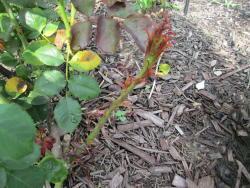From the above article Carol posted:
"The disease causes the plant to be exceptionally susceptible to freeze damage."
From the threads that were posted after Dave posted the following article: "Scientists Seek Public Assistance in Tackling Rose Rosette Disease"
https://garden.org/ideas/view/...
Neal stated on 10/28/2017: "I have read that RRD decreases the plants cold hardiness, and that appears to be the case here. In February 2015 we experienced record low temps of -18*F, with some areas reporting temps as low as -32*F. Most of the infected plants in commercial settings around here were killed or damaged to the point that they had to be removed after that. Since then I've seen only a few infected plants in the area."
https://garden.org/thread/view...
Again Neal wrote something similar on 12/5/2017: "I've read that winter hardiness is diminished by RRD and that is typically what kills the plant, but in zone 7 you may not have cold enough winter for that to be the case. I would recommend removing any plants that continue to show symptoms- it is a disease that can eventually spread throughout your garden."
https://garden.org/thread/view...
On 10/30/2017 Carol stated; "There are some wild roses in the hedgerows that edge my little farm, but I don't know whether they are multiflora. At least some of them are pink and not fragrant, rather than white and fragrant, like multiflora. I'll need to pay more attention to them next year!"
https://garden.org/thread/view...
Carol, have you checked that area recently as a possible source?
